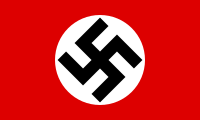|
Flag of Nazi Germany
The flag of Nazi Germany, officially called the Reich and National Flag (German: Reichs- und Nationalflagge[1]), featured a red background with a black swastika on a white disk. This flag came into use initially as the banner of the National Socialist German Workers' Party (NSDAP), commonly known as the Nazi Party, after its foundation in 1920.[2] Shortly after the appointment of Adolf Hitler as Chancellor in 1933, this flag was adopted as mandatory for use, while the national one was the black-white-red triband of the German Empire.[3] One year after death of President Paul von Hindenburg, this arrangement ended. The Nazis banned usage of the imperial tricolour, labelling it as "reactionary",[4] and made their party flag the national flag of Germany as a part of the Nuremberg Laws in 1935,[1] which it remained until the end of World War II and the fall of the Third Reich. HistoryOriginsThe design of the Nazi flag was introduced by Hitler as the party flag in mid-1920, roughly a year before (29 July 1921) he became his political party's leader: a flag with a red background, a white disk and a black swastika in the middle. The flag was designed by Hitler himself, as described in his book Mein Kampf, in which he explained the process by which the Nazi flag design was created, after having presented several proposals:[2]
The Nazi Party was not the only party to use the swastika in Germany. After World War I, a number of far-right nationalist movements adopted the swastika. As a symbol, it became associated with the idea of a racially "pure" state.[2] Soon after Hitler was appointed Chancellor of Germany on 30 January 1933, the black-red-gold tricolour flag of the Weimar Republic was banned; a ruling on 12 March established two legal flags: the reintroduced black-white-red imperial tricolour national flag and the flag of the Nazi Party.[3][5] Actually the new flags were not introduced officially until 14 March 1933, although this usage may have formally started earlier.[6] On 29 April 1933, Interior Minister Wilhelm Frick decreed that all merchant ships had to fly the black-white-red ensign at the stern and the flag of the Nazi Party on the signal stay or starboard signal yard.[7] First national flag of Nazi Germany (1933–1935), corresponding the flag of the North German Confederation (1867–1871) and the German Empire (1871–1919). Initially, the official specification for the Nazi flag placed the white disk, containing the swastika, in the middle of the flag. However, on 20 December 1933 a decree was issued authorising an off-centred version of the swastika flag for use at sea.[8] This was purely a practical decision intended to make the emblem more visible (because when a flag is flying briskly, the outer half appears shorter than the half next to the staff and the centred white circle would appear to be more towards the fly). Moreover, although the Nazi flag on land had the swastika on both sides "right-facing," the Nazi flag at sea displayed the swastika on the reverse side as a "through and through" or mirror image, so the flag had a "right-facing" swastika on the front (or obverse) side and a "left-facing" swastika on the back (or reverse) side. It is not absolutely known when the reverse of the swastika flag at sea was changed, but it can be assumed that this change was made as part of the regulations of 20 December 1933. The reasons were the same in each case: to improve the appearance ("optical proportions") of the flag when used at sea, and improve the visibility of the important design elements (by eliminating potential reverse-shadowing of the dark swastika on the white circle, especially in bright sun light).[5][9]  On 15 September 1935, one year after the death of Reich President Paul von Hindenburg, the Nazi flag became the national flag and ensign of Germany.[1] One reason for the change may have been the "Bremen incident" of 26 July 1935, in which a group of demonstrators in New York City boarded the ocean liner SS Bremen, tore the Nazi Party flag from the jackstaff, and tossed it into the Hudson River. When the German ambassador protested, US officials responded that the swastika was not the German national flag (unlike the black-white-red tricolour) and therefore the perpetrators could not be criminally prosecuted and punished due to the absence of elements of crime, as the German national flag had not been harmed, but only a political party symbol.[10] The new flag law, which had been issued as a part of the Nuremberg Laws,[1] was announced at the annual party rally in Nuremberg in 1935,[11] where Hermann Göring claimed the old black-white-red flag, while honoured, was the symbol of a bygone era and under threat of being used by "reactionaries".[4] Until 15 September 1935, the offset version of the flag was confined to the civil ensign on German-registered merchant ships as well as the jack of the warships, but on 15 September 1935, merchant flag and national flag were unified and were henceforth identical except for their reverse side. There was therefore some confusion after the war about this arrangement. Allied soldiers deemed the centred disk versions of the swastika flag to be "national flags", so a lot of publications later maintained, mistakenly, that the centred disk version was used until the end of World War II. In fact, the only centred disk versions of the flag used after 1935 were the party flags of the Nazi Party.[5]  SymbolismThe Nazi flag takes its colours from the imperial tricolour, with Hitler writing that he "was always for keeping the old colours", because he saw them as his "most sacred possession" as a soldier, and also because they suited his personal taste.[12] Hitler added new symbolism to the colours, stating that "[t]he red expressed the social thought underlying the movement. White the national thought", and that the black swastika was an emblem of the "Aryan race" and "the ideal of creative work which is in itself and always will be anti-Semitic."[12] Since 1945At the end of World War II, after the defeat of Nazi Germany, the first law enacted by the Allied Control Council on 20 September 1945 abolished all symbols and repealed all relevant laws of the Third Reich.[13] The possession of swastika flags has been forbidden in several countries since then, with the importation or display of them forbidden particularly in Germany. Prominent alt-right activists were instrumental in organising the "Unite the Right" rally in Charlottesville, Virginia, United States in August 2017. Here, rally participants carry Confederate battle flags, Gadsden flags, a Nazi flag and a flag depicting Mjölnir. Participants in a nationalist march in Munich (2005) resorted to flying the Reichsflagge and Reichsdienstflagge of 1933–1935 (de) (outlawed by the Nazi regime in 1935) due to § 86a. Today, the Nazi flag remains in common use by neo-Nazi supporters and sympathisers, outside Germany, while within the country, neo-Nazis use the Fatherland Flag from the German Empire instead, due to ban on the Nazi flag use. However, the imperial flag did not originally have any racist or anti-Semitic meaning.[14] See also
References
External links |
||||||||||||||||||||||||||||





